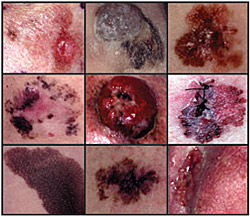
Am Fam Physician. 2005;72(2):206
Summer is a good time to remind patients of the dangers of overexposure to the sun. As you know, skin cancer is the most common malignancy in the United States, and many Americans do not take the necessary precautions. Although melanoma is a relatively small subset of all skin cancers, it is increasingly common, affects a younger population than most cancers, and can be deadly. The article on page 269 is a valuable refresher course on melanoma for all physicians. It includes an overview of the risk factors, screening procedures, prevention recommendations, and treatment guidelines.
Annual Clinical Focus
Our focus on medical genomics continues in this issue with another mini-review. This review focuses on fetal alcohol spectrum disorders caused by maternal alcohol consump tion during pregnancy (see page 279). It includes several photo graphs depicting the patterns of facial anomalies characteristic of these disorders. Central nervous system impairment, cognitive deficits, and behavioral anomalies may not be apparent in a child for several years. Therefore, diagnosis based on specific facial findings is important.

This mini-review includes a new glossary of genomics terms. This glossary will be included in future reviews and is now available on the AAFP web site athttps://www.aafp.org/journals/afp/genomics-glossary.html.
Foreign body ingestion
As a parent, I understand how easy it is for toddlers to find and swallow objects not meant to be eaten. If a child does ingest a foreign body, parents and physicians need to be vigilant for signs of serious complications such as bowel obstruction and perforation to ensure that the object passes spontaneously and that such complications are avoided. The article on page 287 includes a list of presenting symptoms that indicate esophageal foreign bodies, though many patients may be asymptomatic. It also offers two algorithms for the identification of ingested foreign bodies and treatment of those patients. A patient education handout also is included.
Other highlights of this issue
The Graham Center One-Pager series on the physician workforce continues with an article about the National Health Service Corps (NHSC) (page 235). The NHSC health centers have been providing quality health care to low-income and medically underserved communities for many years. Many of the physicians who serve in such communities are family physicians and general practitioners. Future workforce planning should consider how any changes in physician training would affect the NHSC and similar programs.
The Centers for Disease Control and Prevention has issued guidelines for improving vaccination rates for influenza, pneumonia, and hepatitis B among high-risk adults younger than 65 years. You can obtain more information in Practice Guidelines on page 338.
This issue also includes an article on the diagnosis of Lyme disease based on serologic testing, endemicity, and clinical findings. This article provides a detailed discussion of the clinical presentation of Lyme disease, appropriate laboratory tests, and diagnostic strategies (see page 297). A patient education handout is included as well.
Comments welcome
As always, we appreciate your feedback and suggestions for AFP. Feel free to send us an e-mail atafpedit@aafp.org, or return the comment card included in each issue.